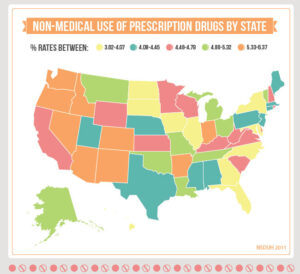Within the past decade or so, patients are finding themselves visiting physicians with complaints of serious aches and pains, and leaving with a recommendation to take Tylenol every few hours, or to visit a specialist – but specialists are expensive and Tylenol just doesn’t cut it. This typically upsets patients and asserts the belief that their physician believes they are a ‘drug seeker’. In reality, some physicians don’t want to prescribe heavy duty pain killers to people they believe may not really need them, and part of this is due to America’s growing addiction to prescription medication.
Prescription Drug Abuse in America
America’s ‘War on Drugs’ began in 1971, and unfortunately, the end is no where in sight. Within the past decade or two, a lot of time, money and energy put into this fight has shifted from marijuana-related charges, to opioids like heroin and prescription pain killers. The number of prescription drug related overdoses in the United States has been rising steadily within the past 15 years, with about 9,000 overdoses in 2001 to a whopping 26,000 in 2014.
Here are some other scary statistics to prove just how addicted Americans are to opioids:
- America is 5% of the world’s population, but it accounts for 75% of its prescription drug abuse.
- 52 million U.S. Citizens (all over the age of 12) have used prescription drugs ‘non-medically’ at one point in their life.
- 62% of teens use prescription drugs because they are easy to obtain from parents.
- 18% of non-medical prescription drugs were obtained by one doctor, while about 2% was obtained by more than one doctor.
Despite the fact that 54 percent of prescription drug abusers obtained the drugs from a friend or relative for free, the DEA decided to crack down on the physicians prescribing these drugs.
DEA Laws Related to Prescription Drug Abuse
Following the introduction of OxyContin in 1995, pain medication prescriptions raised quickly and steadily, and by the first decade of the new millennium, pain killer prescriptions had jumped by about 500 percent, and have continued increasing since. Upsettingly, this increase coincides with the amount of pain medication related over doses. So, the DEA decided to take a stand.
In laymen’s terms, the DEA limited accessibility to certain prescription pain medications, forcing patients who have previously been prescribed the medication, to go without it. They have labeled drugs, such as Hydrocodone, a Schedule II drug, making it less obtainable. Along with this, it has restricted phone-in refills, and requires patients to attend an appointment every 90 days.
What many believe the DEA doesn’t account for, is that upwards of 90 percent of prescription drugs sold on the streets were obtain through pharmacy and warehouse theft, not from crooked doctors.
Are physicians scared and are patients suffering?
The restrictions and constant watch on prescription medication has seemed to scare some physicians out of prescribing pain medications, but what we don’t realize is the amount of patients suffering from these restrictions. The risk of addiction in those that are receiving the medication for pain needs is actually lower than those that obtain the medication another way. After assessing the changes to the regulations, the DEA found that 71 percent of patients were switched to less effective medications, and these patients believe it is due to their doctors fear of legal issues. Another 27 percent reported suicidal thoughts due to their inability to relieve their pain.
Despite all of this, physicians do have to be extremely cautious, because drug seeking is more popular than ever. Unfortunately those that do not need prescription pain medication will fool their physicians into believing they do need it, and either abuse it themselves, or sell it for others to abuse.
This topic continues to be controversial and advances in this debate has slowed, but many people still argue over whether or not physicians are right to prescribe long term pain medication prescriptions, or if the DEA was correct in taking a stand against the frequent use of pain medication.


April 18, 2019
This topic of physicians being afraid to write for pain meds really hits home for me. Being a retired Podiatrist, I was only fooled 2 times by patients seeking pain meds. One of them was referred to another physician for treatment, but I then found out what he was doing so immediately notified the other doc. The other was when I had a few scripts stolen, but my reporting this to the state society, police, and the drugstores where they were filled, no follow up was ever done. The last 4 years , I have had chronic nerve pain in the right abdominal area, probably caused either by my cystectomy or inguinal hernia repair. Despite treatments ranging from lidocaine injections, cortisone shots, radio frequency ablation, sacral nerve procedures, spinal cord stimulator, various meds for “neuropathy and off label anti depressants, cbd oil, etc nothing helps. The fear of not easing the pain is overwhelming, and the looks when requesting pain meds are demeaning. Even my internist of 10 years plus is afraid to prescribe, and pain mgmt should be renamed pain mismgmt, as the only thing that can help me function normally, is severely restricted, so I cannot have any quality of life.